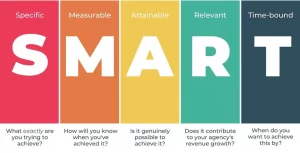Table of Content

- Social media
How to Create a Social Media Strategy
A social media presence is absolutely necessary for businesses and organisations and thus deserves a lot of attention. Marketing and communication via Social Media has great potential, whether you are present on many or a few selected channels. If you want to do exceptionally well, if not outperform the competition, you must have a social media strategy for how your social media work can support your company’s goals.
What is a Social Media Strategy?
A social media strategy is an outline of everything you intend to do and, more importantly, everything you intend to accomplish through social media.
The more specific your strategy, the more effective its implementation. It is critical to be specific and not create a plan that is so broad that you cannot meet your objectives or measure your progress. However, laying out your social media strategy does not have to be difficult. Below you’ll find 7 easy steps to creating a strategy that will help your business succeed on social media.
1. Set goals that matches your business goals
The first thing you should do is to define the goal of your project. It is not enough to only be present, you must measure the impact of your work and the return on investment (ROI).
When it comes to setting and achieving goals, the S.M.A.R.T. model can come in handy.
2. Who is your target audience?
A target audience is the number of people in a market who your company addresses and focuses on. Your target audience is often defined quite naturally, which means that if you sell football boots, your target audience is footballers.
Your target group also determines where your company’s focus should be based on demand, wishes, and needs for the products, services, and services that you provide. This includes your marketing as well.
It is a good idea to conduct a target audience analysis before developing a social media strategy.
This type of analysis can assist you in segmenting your target group so that you can target your message to the exact people you want to reach.
From a good target audience analysis you can learn:
- What interests your target audience has
- How your target group uses and perceives the services you provide
- Which social media platforms your target audience use
- The location of your target audience
- Information such as age, gender and occupation
Based on the above information you can create a persona. It enables you to consider your potential followers or customers as real people with genuine wants and needs.
However, good personas are not created based on gut feelings, so let the data speak for itself.
Social media data can provide you with a wealth of information about your target audience, including where they live and how they interact with you (or your competitors) on social media. A persona is an archetype of your target audience or customer that includes specific information about them. It could be their needs and pain points, for example. Understanding your target audience allows you to fine-tune your strategy and better target your content and campaigns.
3. Research your competitors
Your competitor is most likely already gaining customers through social media. However, just because your competitor has more followers and interactions than you does not mean the battle for customers is over.
Investigate how your competitor uses social media and be inspired. A competitor analysis allows you to understand their strengths and weaknesses.
Examining competitor behaviour can also help you spot opportunities. If one of the competitors is extremely dominant on a channel, it may be advantageous to occupy another channel rather than compete.
Your time and effort may be better spent building a community on another channel rather than competing with an already dominant player.
You can also use social listening to monitor your competitors on social media. Social listening entails listening in on social media conversations, which can provide valuable insights. You can monitor your competitors’ profiles or relevant keywords with social listening, and you can keep track of what works – and doesn’t work – for them.
By analysing competitors and using social listening, you can gain insight not only into your competitors, but also into the industry as a whole. It improves your ability to plan a social media strategy.
4. Review what you have today
Your company most likely already has a Facebook page or an Instagram profile. When developing a social media strategy, it is important to examine existing profiles and channels. What has already been accomplished? And what progress has been made with current efforts?
The goal is to ensure that the company’s profiles are consistent and perform as expected.
Your examination of existing profiles and pages should provide a clear picture of the purpose of each of your social channels. If the purpose of an account is unclear, it is worth considering whether it should be kept or redirected strategically.
It can be difficult to close one of the company’s accounts, but it keeps your social media strategy on track and makes it easier to improve your results.
After you’ve evaluated your existing channels and their relevance, take a look at the data you have for each individual channel. Looking at the results of previous posts may already provide you with some insights into your Instagram presence. This gives you a good starting point for future improvement.
5. Make a strategy for each social media channel
After deciding which channels to focus on, you must develop a strategy for each channel.
Each channel’s purpose is defined by a channel strategy. For example, you may intend to use Instagram Reels for tutorials while only using Twitter for support.
Each channel strategy’s purpose should be able to be described in one sentence. It keeps things simple and helps you stay focused on the specific goals you’ve set.
Following that, it’s time to create profiles for the channels you’ve decided to focus on in your strategy – or improve your existing profiles to align with the strategic plan. Fill out all profile fields and use relevant keywords and images in the appropriate sizes for each network.
6. Develop good content
Good content is essential in digital marketing and social media, so consider what you want to share on social media as an important step in preparing your social media strategy.
The first and most important criterion for your content is that it is consistent with the brand. As a result, consider the tone of your content. Should it be formal or informal? Are emojis permitted? Do you and your coworkers sign your names, initials, or nothing at all?
There are undoubtedly many terms and concepts that are unique to your industry. Consider developing policies outlining how they should and can be used. Please also look for relevant hashtags that can be used. Then there are the formats to consider. How much should video cost? Text? Pictures? And how frequently will you share content across the various channels?
Of course, all of these considerations must be consistent with the goals of your social media strategy and the purpose you have defined for each channel.
Content Planning
After you’ve considered tone, concepts, and formats, you can create a content strategy.
A content plan provides an overview of which content should be shared on which channel and when, as well as an overview of how your content supports business goals.
You can, for example, divide your content to keep the focus on the overall goals. For example, 25% of the content must be about driving traffic to the website (if that is your goal), or 5% must be about HR and company culture (if that is your goal).
However, there are numerous approaches.
If you’re starting from scratch and aren’t sure what type of content will be effective, follow the 80-20 rule:
- 80% of your content should be informative, educational or entertaining your audience.
- 20% of your content may promote your company’s brand.
A content plan allows you to create your content ahead of time, which often improves the quality and provides more opportunities to create strategic content. Of course, there must be room for impromptu notices.
7. Test, evaluate and adjust your Social Media Strategy
The six steps we’ve taken thus far should result in a solid SoMe strategy. To ensure that your strategy remains relevant and that you get the most out of it, it is critical to collect data about your activities on a regular basis, evaluate it, and then adjust. It is perfectly normal not to have calculated everything from the beginning.
Look at the data when a campaign did not go as well as you had hoped – and look at the data when a campaign far exceeded your expectations. Perhaps your strategy can be tweaked so that far more of your campaigns are the latter rather than the former.
Determine the ROI of your activities as well. Of course, this depends on whether your goal is brand awareness, revenue, customer satisfaction, or something else. However, consider the value your campaign has provided in comparison to the time and money you spent on it.
You can use data to continuously evaluate as it begins to flow. It enables you to fine-tune your strategy in real-time.
Changes to your Social Media strategy is great
Social media is rapidly evolving. New channels are arising, while others are undergoing significant demographic changes. Because your company will go through periods of change, your social media strategy must be a tool that can be adjusted as needed.
Don’t be afraid to change your social media strategy to reflect any new goals, tools, or plans. It is only important that the entire team is aware so that you can work toward a common goal and be successful on social media (as well as internally).
Once you’ve established your strategy, you’ll need a platform to manage all of your channels and content. There are numerous options available, and Hootsuite allows you to plan content, monitor channels and keywords, and measure your efforts.




![happy-young-asia-businessmen-businesswoman-meeting-brainstorming-some-new-ideas-about-project-scaled (1) Top 10 Digital Marketing Agencies In Thailand [2024]](https://www.ibex.co.th/wp-content/uploads/elementor/thumbs/happy-young-asia-businessmen-businesswoman-meeting-brainstorming-some-new-ideas-about-project-scaled-1-qji23hztd22xdvln8gjfucufhgiekie3sh7loq8di6.webp)





